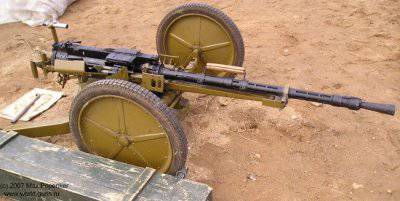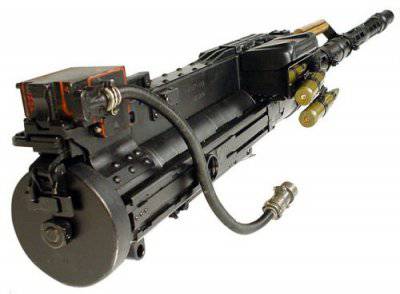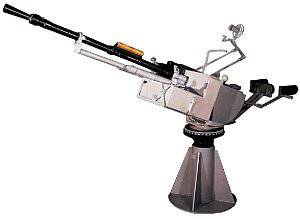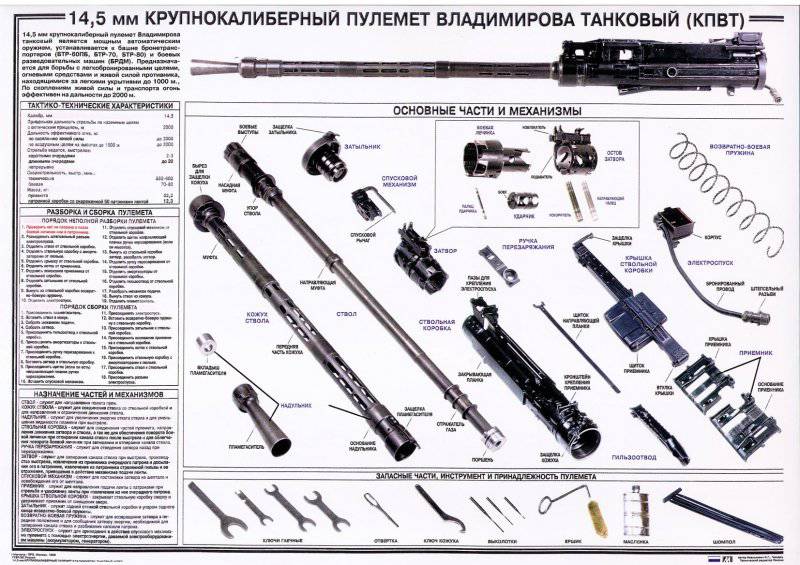Anti-tank machine gun Vladimirova KPV-44
The solution was to abandon automatic fire and create anti-tank rifles. Immediately before the Great Patriotic War, several types of these weapons were created in the Soviet Union and two of them were adopted - the guns of Simonov and Degtyarev (PTRS and PTRD, respectively). Both guns, as well as those not launched into the series of guns of Vladimirov, Shpitalny, Rukavishnikov, etc., were designed under the cartridge of 14,5x114 mm. The power of guns with this cartridge was enough to penetrate German armor tanks, mainly PzKpfw III and PzKpfw 38 (t) with their relatively thin armor. However, the armor of subsequent tank models was thicker and was no longer so easily amenable to anti-tank rifles. In this context, historians like to recall a letter from front-line soldiers to the gunsmith V.A. Degtyarev, written in August 42nd: in it they expressed their thoughts about heavy machine guns. The dream of the war veterans was a machine gun with the penetrative characteristics of an anti-tank gun. It could be used not only against enemy armored vehicles, but also against manpower and aviation. Moreover, in the latter cases, its effectiveness would be greater than that of the existing 12,7 mm caliber DShK.
 The People's Commissariat of Armaments and the Main Artillery Directorate took into account the soldiers' opinion, and in December of the same year requirements for a machine gun were formed; an existing 14,5x114 mm was chosen as the patron for it. In 1943, at the Kovrov Plant No. XXUMX them. K.O. Kirkizha was created three versions of the machine gun under the requirements of GAU. All of them had automatics on the basis of gas removal, but the shutter was locked in different ways. However, tests have shown that the gas automatics is not too friendly with the powerful 2-mm cartridge: because of the high pressure of the gases, the piston jerked so sharply that problems began with sending the cartridge and extraction of the sleeve.
The People's Commissariat of Armaments and the Main Artillery Directorate took into account the soldiers' opinion, and in December of the same year requirements for a machine gun were formed; an existing 14,5x114 mm was chosen as the patron for it. In 1943, at the Kovrov Plant No. XXUMX them. K.O. Kirkizha was created three versions of the machine gun under the requirements of GAU. All of them had automatics on the basis of gas removal, but the shutter was locked in different ways. However, tests have shown that the gas automatics is not too friendly with the powerful 2-mm cartridge: because of the high pressure of the gases, the piston jerked so sharply that problems began with sending the cartridge and extraction of the sleeve.In May, the 43 group of Kovrov designers from the Chief Designer Department (WGC) of Plant No. XXUMX under the leadership of S.V. Vladimirova pulled out from under the cloth a draft of an aviation cannon B-2. Despite the fact that the gun last year lost the competition for the Berezin B-20 cannon, it was decided to take it as a basis. The main reason for the appeal to the B-20 was covered in the system - this gun had automation with a short barrel stroke. Alteration of the gun in a machine gun was tense, but quickly - the war required not to pull. Already in November, the machine gun was sent to factory tests, and in February, the 20 was installed on a universal (tripod and wheels) machine designed by Kolesnikov and sent to the Scientific Test Site of small arms and mortar weapons. Two months later, the GAU was requested from the Kovrov plant to submit 44 machine guns on machine tools and one anti-aircraft gun for military tests. At the same time, the machine gun was named: “Vladimirov heavy machine gun model 50 of the year” or simply KPV-1944. However, the plant was loaded with work for the needs of the front and military trials began only after the Victory, in May 44.
On military tests, the shortcomings of universal machines were revealed: they were inconvenient in operation and behaved if not like the second machine gun from the "Wedding in Robin" ("the other, like crazy, bounces"), then at least unstable. I had to abandon a single machine for all machine gun options. In the 46th, tests of several anti-aircraft machines for KPV-44 at once began: single, double and quadruple, which later became the basis for the anti-aircraft installations ZPU-1, ZPU-2 and ZPU-4. All antiaircraft guns are developed by OGK of Plant No. 2. The infantry wheeled machine had to wait longer - until 1948. Then, from a number of options, a design machine of A. Kharykin (Leningrad, OKB-43) was selected, finalized in Kovrov. Around the same time, a pedestal, turret and turret installation was created for the use of CPV on navy.
Almost seven years after the legendary letter to Degtyarev - in 1949 - a large-caliber anti-tank machine gun was finally put into service.
 When adopting the KPV-44, it received a new name: “14,5-mm heavy infantry machine gun Vladimirov” (PKP). Serial production of the control panel was started at the same Kovrov plant, which in 49-m received the name of V.A. Degtyarev. The developers of the machine gun and anti-aircraft machines - S.V. Vladimirov, A.P. Finogenov, G.P. Markov, I.S. Leshchinsky, L.M. Borisova, E.D. Vodopyanov and E.K. Raczynski - received the Stalin Prize.
When adopting the KPV-44, it received a new name: “14,5-mm heavy infantry machine gun Vladimirov” (PKP). Serial production of the control panel was started at the same Kovrov plant, which in 49-m received the name of V.A. Degtyarev. The developers of the machine gun and anti-aircraft machines - S.V. Vladimirov, A.P. Finogenov, G.P. Markov, I.S. Leshchinsky, L.M. Borisova, E.D. Vodopyanov and E.K. Raczynski - received the Stalin Prize.At the beginning of the 50-x CPV-44 was finalized for use on tanks, this modification was named CPVT (CPV tank). In order to be installed on the turret, the pivots or in the split with the gun, the electric transmission was added, the receiver was shortened and the discharge of the spent cartridge cases was moved forward to a greater distance from the receiver.
Like the B-20 cannon, the Vladimirov machine gun has automation based on the recoil of the barrel with a short stroke of the latter. The barrel is locked by turning the bolt, and only the combat larva rotates directly. Turning, she wound with her lugs (on the inside of the larva, see the diagram) behind the lugs on the outer surface of the breech breech. The protrusions of the larvae and the trunk are interrupted threads, as on some artillery pieces. The larva has a pin sliding in the slot of the receiver - this ensures its rotation.
Barrel KPV has the ability to quickly replace and is attached to the receiver on the latch. When changing, the barrel is removed together with the perforated casing; for this purpose, a special handle is provided on the casing. It can also be used to carry a machine gun. At the end of the trunk is expanding muzzle.
 The machine gun is powered from metal tapes on 40 (control panels) and 50 (CPVT) cartridges. The tape can be received from both sides - only a small reinstallation of the tape receiver is required. However, of greater interest is the feed mechanism of cartridges in the chamber. On the gate is a special bracket-extractor. When moving the bolt back, he pulls the cartridge out of the tape. Next, the cartridge goes down to the level of the chamber and, when the shutter moves forward, is sent to it. The cartridge case goes down and is ejected through a short sleeve tube. At KPVT, it was slightly elongated.
The machine gun is powered from metal tapes on 40 (control panels) and 50 (CPVT) cartridges. The tape can be received from both sides - only a small reinstallation of the tape receiver is required. However, of greater interest is the feed mechanism of cartridges in the chamber. On the gate is a special bracket-extractor. When moving the bolt back, he pulls the cartridge out of the tape. Next, the cartridge goes down to the level of the chamber and, when the shutter moves forward, is sent to it. The cartridge case goes down and is ejected through a short sleeve tube. At KPVT, it was slightly elongated.CPV can conduct only automatic fire, shooting is conducted from an open shutter. The trigger mechanism is usually located separately: in the infantry version of the machine gun - on the machine, in the tank there is a remotely controlled electric release. The machine gun on the infantry machine for fire control has two vertical handles and a release key between them. The reload of the machine gun is carried out with the help of a side grip (infantry variant) or a pneumatic cylinder (KPVT). Own sight on KPV is not provided, however the optical sight is available on the infantry machine. On anti-aircraft machines, in turn, the corresponding sights are installed.
For use in the CPV, there are several variants of the cartridge 14,5х114 mm. They differ only in the types of bullets: from the armored-piercing B-32 and incendiary MDZ to the sighting-incendiary RFP and even the combined armor-piercing-chemical BRU. In the latter case, a small container with chloroacetophenone was placed in the bottom of the core: after penetrating the armor, the inside of the machine was filled with a gas-lacrimator. This bullet was developed for anti-tank guns, but was not widely used. After the appearance of the CPV, it also did not become a mass ammunition.
Separately, it is worth noting the indicators of armor penetration. At the beginning of the 70's, the Americans, not without grief, learned that the CPV at a distance of about 500-600 meters penetrates the frontal armor (38 millimeters) of the main US armored personnel carrier M113. It is believed that it was after this that the growth of the thickness of the armor began and, as a result, the weight of the NATO light armored vehicles.
The machine gun CPV was delivered to more than three dozen countries. In addition to the USSR, the machine gun was produced in China and Poland. A similar situation exists with the cartridge 14,5х114 mm. At the moment, in different parts of the world, a huge number of different types of CPVs are being used on various machines. Also in the press regularly appear photos, which depict the CPV, attached to the next "technicals".

Information